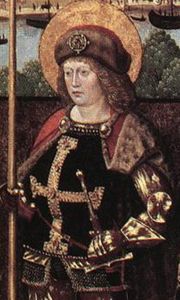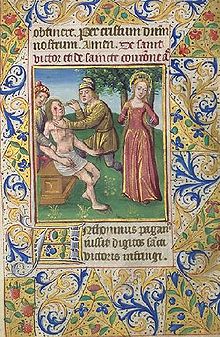Gavinus is a Christian saint who is greatly celebrated in Sardinia, Italy, as one of the Martyrs of Torres, along with his companions Protus, a bishop, and Januarius, a deacon.

Saint Lawrence or Laurence was one of the seven deacons of the city of Rome under Pope Sixtus II who were martyred in the persecution of the Christians that the Roman Emperor Valerian ordered in 258.

Agathaof Sicily is a Christian saint. Her feast is on 5 February. Agatha was born in Catania, part of the Roman Province of Sicily, and was martyred c. 251. She is one of several virgin martyrs who are commemorated by name in the Canon of the Mass.

Ursula was a Romano-British virgin and martyr possibly of royal origin. She is venerated as a saint in the Roman Catholic Church and the Anglican Communion. Her feast day in the pre-1970 General Roman Calendar and in some regional calendars of the ordinary form of the Roman Rite is 21 October.

Vincent of Saragossa, the Protomartyr of Spain, was a deacon of the Church of Saragossa. He is the patron saint of Lisbon and Valencia. His feast day is 22 January in the Catholic Church and Anglican Communion and the Orthodox Church, with an additional commemoration on 11 November in the Orthodox Church. He was born at Huesca and martyred under the Emperor Diocletian around the year 304.

Pancras was a Roman citizen who converted to Christianity and was beheaded for his faith at the age of fourteen, around the year 304. His name is Greek (Πανκράτιος) and means "the one that holds everything".

Saint Acacius, also known as Agathius of Byzantium, Achatius, or Agathonas to Christian tradition, was a Cappadocian Greek centurion of the imperial army, martyred around 304. A church existed in Constantinople associated with Acacius and possibly named after him: the Church of St Acacius.

The Four Crowned Martyrs or Four Holy Crowned Ones were nine individuals who are venerated as martyrs and saints of Early Christianity. The nine saints are divided into two groups:
- Severus, Severian(us), Carpophorus (Carpoforus), Victorinus
- Claudius, Castorius, Symphorian (Simpronian), Nicostratus, and Simplicius

Gereon of Cologne, who may have been a soldier, was martyred at Cologne by beheading, probably in the early 4th century.

Symphorosa is venerated as a saint of the Catholic Church. According to tradition, she was martyred with her seven sons at Tibur toward the end of the reign of the Roman Emperor Hadrian (117–38).

Valeria of Milan, or Valérie, according to Christian tradition, was the wife of Vitalis of Milan and the mother of Gervasius and Protasius.

Saint Honorina was a 3rd-century virgin martyr of Gallo-Roman northern France, venerated as a saint in the Catholic and Eastern Orthodox Churches. Believed to have been killed in the first years of the 4th century during the persecutions of Diocletian, very little is known of her life, apart from her reputed martyrdom for maintaining her Christian faith.

SaintCaesarius of Terracina was a Christian martyr. The church of San Cesareo in Palatio in Rome bears his name.

Saints Marcellinus and Peter are venerated within the Catholic Church as martyrs who were beheaded. Hagiographies place them in 4th century Rome. They are generally represented as men in middle age, with tonsures and palms of martyrdom; sometimes they hold a crown each.

Saints Victoria, Anatolia, and Audax are venerated as martyrs and saints by the Catholic Church and Eastern Orthodox Church. Victoria and Anatolia are mentioned in the Roman Martyrology under the date of 10 July. Anatolia was first mentioned in the De Laude Sanctorum composed in 396 by Victrice (Victricius), bishop of Rouen (330–409).

Restituta is a Berber saint and martyr of the Roman Catholic and Eastern Orthodox Churches. She was said to have been born in Carthage or Teniza and martyred under Roman Emperor Diocletian. The location and date of her martyrdom are not precisely known. She sometimes is considered one of the Martyrs of Abitinae, Roman Province of Africa, a group of North Africans including Dativus, Saturninus, et alia, who were martyred in AD 304.
Simplicius, Constantius and Victorinus are venerated as Christian martyrs of the 2nd century. Simplicius, was, according to tradition, a Christian of the Abruzzi region who was executed along with his two sons, Constantius and Victorian, during the reign of Marcus Aurelius. Their Passio contains all of the tropes of the genre. It is believed that the martyrdoms are genuine but that the three martyrs were not necessarily related to one another, but were executed together at Marsica.
Pontianus was a second century Christian martyr. He was martyred during the reign of the Emperor Marcus Aurelius. He is honored as a saint and martyr by the Catholic Church, the Old Catholic Church, and the Eastern Orthodox Church. In Spoleto, Italy, he is invoked for protection against earthquakes.

Christina of Bolsena, also known as Christine of Bolsena, or in the Eastern Orthodox Church as Christina the Great martyr, is venerated as a virgin martyr of the third century. Archaeological excavations of an underground cemetery constructed over her tomb have shown that she was venerated at Bolsena by the fourth century.

Luxurius or Luxorius was an ancient Roman official on Sardinia in the late 3rd and early 4th centuries. Apparitor to Delphius, the praeses or governor of the island, he was converted to Christianity by reading the Psalms. He possibly was beheaded on 21 August for refusing to sacrifice to idols in the city of Forum Traiani, probably in 304 during the fourth of Diocletian's persecutions. Later he was venerated as a martyr and saint by the Roman Catholic Church.


















